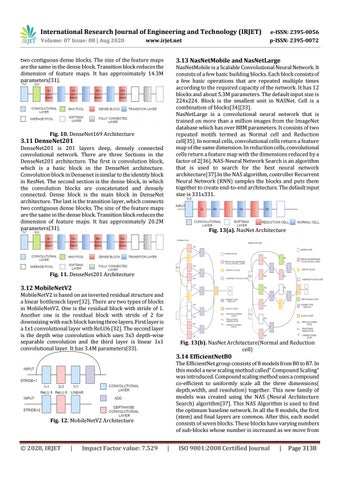International Research Journal of Engineering and Technology (IRJET)
e-ISSN: 2395-0056
Volume: 07 Issue: 08 | Aug 2020
p-ISSN: 2395-0072
www.irjet.net
3.13 NasNetMobile and NasNetLarge
two contiguous dense blocks. The size of the feature maps are the same in the dense block. Transition block reduces the dimension of feature maps. It has approximately 14.3M parameters[31].
NasNetMobile is a Scalable Convolutional Neural Network. It consists of a few basic building blocks. Each block consists of a few basic operations that are repeated multiple times according to the required capacity of the network. It has 12 blocks and about 5.3M parameters. The default input size is 224x224. Block is the smallest unit in NASNet. Cell is a combination of blocks[34][33]. NasNetLarge is a convolutional neural network that is trained on more than a million images from the ImageNet database which has over 88M parameters. It consists of two repeated motifs termed as Normal cell and Reduction cell[35]. In normal cells, convolutional cells return a feature map of the same dimension. In reduction cells, convolutional cells return a feature map with the dimensions reduced by a factor of 2[36]. NAS-Neural Network Search is an algorithm that is used to search for the best neural network architecture[37].In the NAS algorithm, controller Recurrent Neural Network (RNN) samples the blocks and puts them together to create end-to-end architecture. The default input size is 331x331.
Fig. 10. DenseNet169 Architecture
3.11 DenseNet201
DenseNet201 is 201 layers deep, densely connected convolutional network. There are three Sections in the DenseNet201 architecture. The first is convolution block, which is a basic block in the DenseNet architecture. Convolution block in Densenet is similar to the identity block in ResNet. The second section is the dense block, in which the convolution blocks are concatenated and densely connected. Dense block is the main block in DenseNet architecture. The last is the transition layer, which connects two contiguous dense blocks. The size of the feature maps are the same in the dense block. Transition block reduces the dimension of feature maps. It has approximately 20.2M parameters[31].
Fig. 13(a). NasNet Architecture
Fig. 11. DenseNet201 Architecture
3.12 MobileNetV2
MobileNetV2 is based on an inverted residual structure and a linear bottleneck layer[32]. There are two types of blocks in MobileNetV2. One is the residual block with stride of 1. Another one is the residual block with stride of 2 for downsizing with each block having three layers. First layer is a 1x1 convolutional layer with ReLU6 [32]. The second layer is the depth wise convolution which uses 3x3 depth-wise separable convolution and the third layer is linear 1x1 convolutional layer. It has 3.4M parameters[33].
Fig. 13(b). NasNet Architecture(Normal and Reduction cell)
3.14 EfficientNetB0
The EfficientNet group consists of 8 models from B0 to B7. In this model a new scaling method called” Compound Scaling” was introduced. Compound scaling method uses a compound co-efficient to uniformly scale all the three dimensions( depth,width, and resolution) together. This new family of models was created using the NAS (Neural Architecture Search) algorithm[37]. This NAS Algorithm is used to find the optimum baseline network. In all the 8 models, the first (stem) and final layers are common. After this, each model consists of seven blocks. These blocks have varying numbers of sub-blocks whose number is increased as we move from
Fig. 12. MobileNetV2 Architecture
© 2020, IRJET
|
Impact Factor value: 7.529
|
ISO 9001:2008 Certified Journal
|
Page 3138


